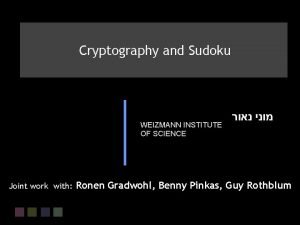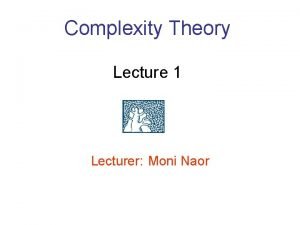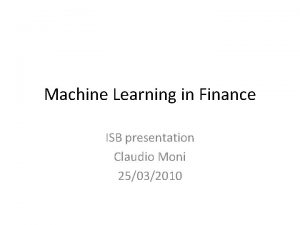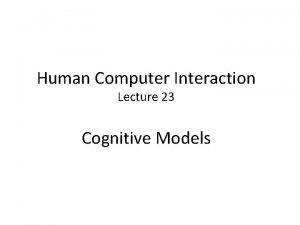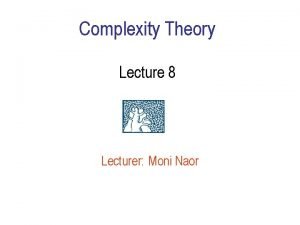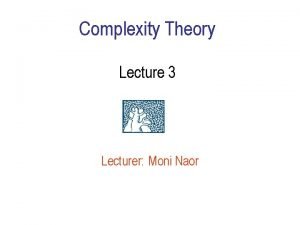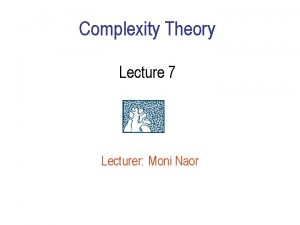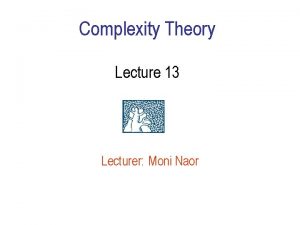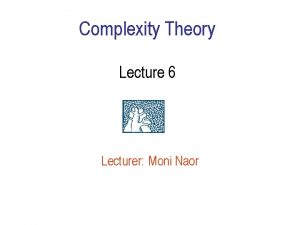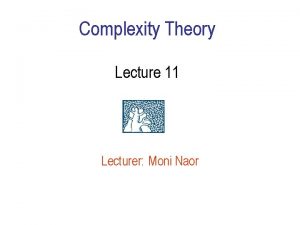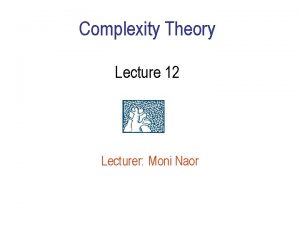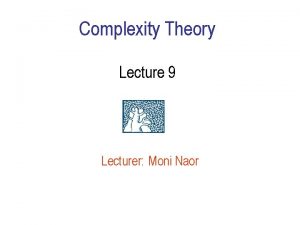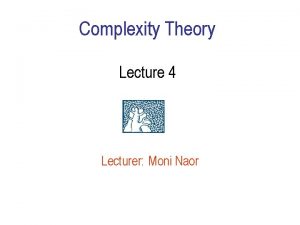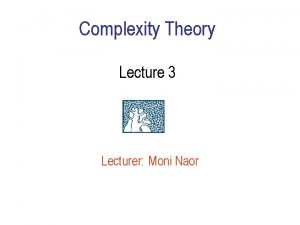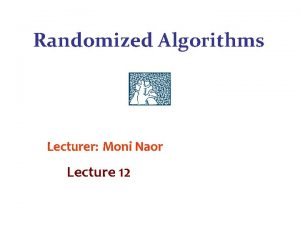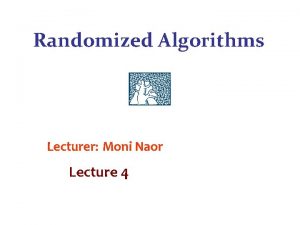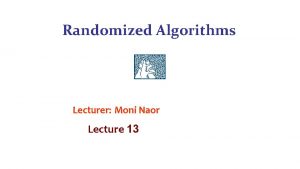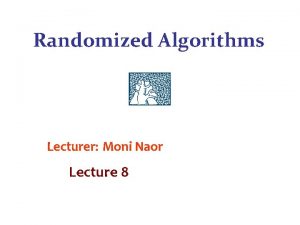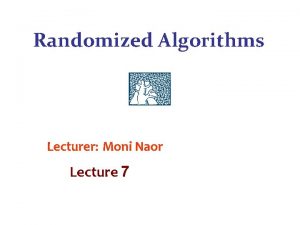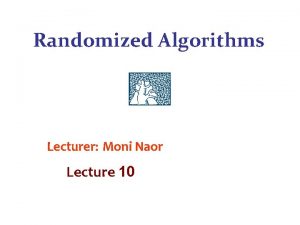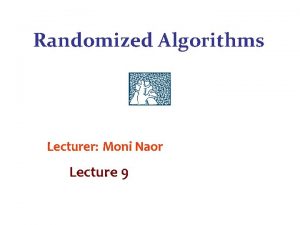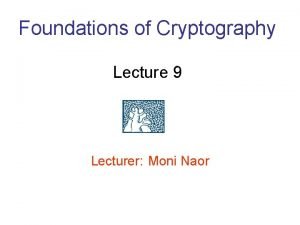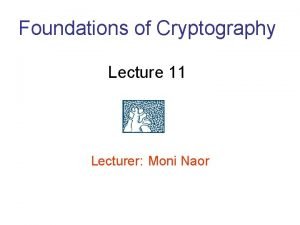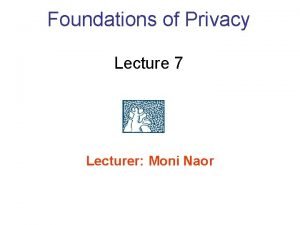Complexity Theory Lecture 4 Lecturer Moni Naor Recap
















![Famous Markov Chain: Page. Rank algorithm [Brin and Page 98] • Good authorities should Famous Markov Chain: Page. Rank algorithm [Brin and Page 98] • Good authorities should](https://slidetodoc.com/presentation_image_h/0ecce1ffab398ad78ae4bf3b3e790afa/image-17.jpg)










- Slides: 27

Complexity Theory Lecture 4 Lecturer: Moni Naor

Recap Last week: Space Complexity • Savitch’s Theorem: NSPACE(f(n)) µ SPACE(f 2(n)) – Collapse of NPSPACE to PSPACE • PSPACE Completeness – TQBF, Games • Logarithmic space – deterministic and non • Sublogarithmic space • Non-deterministic space is closed under complementation This week: Probabilistic Space Complexity

The Central Questions of Complexity Theory Log. Space µ NL µ P µ NP µ PSPACE Are any of the containments proper? All we can say: NL ( PSPACE Since NL µ Space(log 2 n) ( PSPACE from diagonalization (space hierarchy) Is NP = Co-NP? Is P = NP Å Co-NP ? Have not seen yet power of: • Oracles • Interaction • Randomization If P = NP Å Co-NP then factoring is easy

2 -SAT: given a formula = C 1 Æ C 2 … Æ Cm where Ci =( Ç ) where 2 {xj, : xj} and 2 {xk, : xk} for some j and k. Is there a satisfying assumption for ? Let G( ) be a directed graph with – Nodes: literals – Edge ( , ) iff clause (: Ç ) exists Represent the implication the constraint puts Claim: is satisfiable iff for no xi are there both a path from xi to : xi and a path from : xi to xi in G( ) Corollary: 2 -SAT is in NL easy to see 2 -unsat in NL and apply Immerman--Szelepcsenyi

2 -SAT is Complete for NL • Reduce from (un)reachability of DAGs – This is NL-Complete as well • Given a DAG G, source s and target t construct (G): Log space construction – For each node x create variable x – For edge (x, y) 2 G: add clause (: x Ç y) – Add clauses (s) and (: t) Claim: (G) is satisfiable iff there is no path from s to t in G

Algorithm for 2 -SAT • Start with arbitrary assignment • While the assignment is not satisfying – Choose an arbitrary unsatisfied clause Ci =( Ç ) – Choose at random from { , } and flip the assignment to that variable – If unsuccessful for many step stop and declare `unsat’ Analysis: let A 2 {0, 1}n be any satisfying assignment – With probability at least ½ distance to A is reduced – With probability at most ½ distance to A is increased 0 n

Analysis of Algorithm Distance can never be larger than n Want to compute how long it takes a pebble to get with high probability to 0 Dominated: for all t probability exact if it starts at some 0 · i · n process takes more than t steps is at least as the original process Dominated by a walk where – With probability exactly ½ distance to A is reduced – With probability exactly ½ distance to A is increased – When pebble hits 0 it is absorbed – When pebble hits n it is reflected 0 n

Analysis of Random Walks Would like to be able to say: Expected time to visit 0 For what time period can we say that there high probability?

Probabilistic Turing Machines Probabilistic TM: transition function : X Q may be Probabilistic. • A probability distribution on the set of moves X {left, right} – Accuracy • Alternative view: in addition to input tape, random coins tape – How do we count it in space bounded computation • head movement is one-way When is the PTM M considered to recognize a language L: Two sided error: • For all x 2 L we have Pr[M stops with `yes’]>2/3 • For all x 2 L we have Pr[M stops with `no’]>2/3 Always stops One-sided error • For all x 2 L we have Pr[M stops with `yes’]>1/2 • For all x 2 L we have Pr[M stops with `no’]=1 Monte Carlo zero error: M never stops with the wrong answer but might never stop Vs. Want to consider expected consumption of resources Las Vegas

Random Log. Space (RL) • A probabilistic Turing Machine with worktape size O(log |X|) – Long enough to count and assure stopping in time RL: one-sided Error • For all x 2 L we have Pr[M stops with `yes’]>1/2 • For all x 2 L we have Pr[M stops with `no’]=1 BPL: two-sided Error • For all x 2 L we have Pr[M stops with `yes’]>2/3 • For all x 2 L we have Pr[M stops with `no’]>2/3 ZPL: No Error but stopping time is only expected polynomial time Show: ZPL= RL Å Co-RL

Undirected Connectivity and RL • Given an undirected graph G=(V, E) – for nodes s and t, is there a path from s to t. – is the graph connected • Homework: the two versions are log space equivalent via oracle reductions Idea of algorithm: • Perform random walk for certain amount of time • If node t is visited declare connected • Ow unconnected Random walk: If at node u with degree du Choose uniformly at random a neighbor and move to it

Markov Chains • A discrete time stochastic process X 1, X 2, … Xt … – defined over a set of states S • Finite or countably infinite – in terms of transition matrix. P • Entry Pij is probability next state is j given current state is i: Pr[Xt+1 =j|Xt =i] – For all i, j 2 S we have 0 · Pij · 1 and j 2 S Pij = 1 • Memoryless Property: Pr[Xt+1 =j|Xt =i]= Pr[Xt+1 =j|Xt =i, Xt-1 =it-1, … X 0 =i 0] – what matter is where I am, not how I got here • Example: pebble walk on the line S ={0, 1, …, n} For all 1<i<n we have Pii+1 = ½ and Pii-1 = ½ P 00 = 1 and Pnn-1 = 1 all other Pij = 0 0 n

Markov Chains • Initial state distribution q(0)=(q 1(0), q 2(0), … qn(0)) • State probability vector q(t)=(q 1(t), q 2(t), … qn(t)) distribution of the chain at time t q(t+1)=q(t)P and q(t)= q(0)Pt • Stationary distribution: for Markov Chain with transition matrix P is distribution such that = P If a Markov Chain is in a/the stationary distribution at step t it remains so forever Steady state behavior There can be unique, several or no stationary distribution Depending on the initial distribution

Markov Chains • For states i, j 2 S first transition probability rij(t) is probability that given X 0=i first time state j occurs is at step t rij(t)=Pr[Xt =j Æ Xs ≠j, 1 · s < t| X 0 =i] • Probability that there is such a visit fij= t>0 rij(t) • Hitting Time: Let hij be the expected number of steps to reach state j starting from state i. If fij <1 then hij = 1 hij= t>0 t rij(t) converse not necessarily true in infinite chains If fij =1 then state i is called persistent

Markov Chains • Underlying directed graph of a Markov Chain: Edge (i, j) iff Pij > 0 • Markov Chain is irreducible if its underlying graph consists of a single strong connected component • Periodicity of a state i: GCD of the lengths of the path from i back to itself – Bipartite graphs: periodicity 2 – State is aperiodic if it has period 1

Fundamental Theorem of Markov chains For any irreducible, finite and aperiodic Markov Chain: • All states are ergodic (hii < 1) • There is a unique Stationary distribution • For all i 2 S we have – i > 0 – fij = 1 – hii = 1/ i
![Famous Markov Chain Page Rank algorithm Brin and Page 98 Good authorities should Famous Markov Chain: Page. Rank algorithm [Brin and Page 98] • Good authorities should](https://slidetodoc.com/presentation_image_h/0ecce1ffab398ad78ae4bf3b3e790afa/image-17.jpg)
Famous Markov Chain: Page. Rank algorithm [Brin and Page 98] • Good authorities should be pointed by good authorities • Random walk on the web graph – pick a page at random – with probability α follow a random outgoing link – with probability 1 - α jump to a random page • Rank according to the stationary distribution

Random Walks on Graphs Undirected graph G=(V, E), |E|=m, |V|=n • The transition matrix Puv = 1/du if (u, v) 2 E and 0 ow. Claim: is G=(V, E) is connected and non-bipartite then for all v 2 V v =du/2 m Conclusion: huu = 2 m/du How to make the graph non-bipartite? Add self-loops

Cover and Commute time • Commute time Cuv: expected time for a random walk starting at u to reach v and come back Cuv = huv+hvu • Cover time Cu(G): expected length of a walk starting at u, visiting every node at least once. C(G) =maxu Cu(G). Lemma: for any edge (u, v): Cuv = huv+hvu · 2 m Consider Markov chain of (directed) edges. Stationary distribution: uniform (each edge+direction) 1/2 m Time to get from u to v and back on edge (v, u): 2 m Not true for non-edges

Upper bound on Cover Time • Theorem: Cu(G)· 2 m (n-1) Proof: consider any spanning tree T of G. There is a traversal of T v 0, v 1, … v 2 n-2 where each edge of T is traversed once in each direction. Consider random walk starting and ending at v 0, that traverses each of the edge of T once in each direction Upper bound on walk is upper bound on cover time Cu(G)· j=02 n-3 hvj v j+1 = (u, w) 2 T Cuw · (n-1) 2 m At most m, from Lemma Conclusion: taking 4 n 3 as the bound in the random walk suffices for constant probability of success

Universal Traversal Sequences G is a regular graph of degree d • Labeling: the edges neighboring a node are labeled with {1, 2 …d} in an arbitrary manner – Port number • Can we find a polynomial sized sequence of labels s 1, s 2, … sk , si 2 {1, 2 …d} such that following it assures visiting all nodes of the graph Yes, it exists. Use the probabilistic method. • Fix a graph an labeling • Compute probability that sequence is not good for graph • Sum over all graphs (n. O(dn)) A log space construction puts connectivity in log space 4 7

Hot off the press news • Omer Reingold, Undirected ST-Connectivity in Log. Space, Available: Electronic Colloquium on Computational Complexity, Report TR 04 -094 Important Web Resources on Complexity: • ECCC: http: //www. eccc. uni-trier. de • Lance Fortnow’s Computational Complexity Web Log: http: //fortnow. com/lance/complog/

What happens in directed graphs • There are strongly connected directed graphs with an exponential covering time • Can count to doubly exponential space probabilistically • So if we do not insist on always stopping may do directed connectivity in random log space (but exponential time) – uninteresting

Probabilistic Variants of P RP: one-sided Error • For all x 2 L we have Pr[M stops with `yes’]>1/2 • For all x 2 L we have Pr[M stops with `no’]=1 BPP: two-sided Error • For all x 2 L we have Pr[M stops with `yes’]>2/3 • For all x 2 L we have Pr[M stops with `no’]>2/3 ZPP: No Error but stopping time is only expected polynomial time

The Schwartz-Zippel Algorithm/Theorem: Let Q(x 1, x 2, …, xn) 2 F(x 1, x 2, …, xn) be a non-zero muitivariate polynomial of total degree d. Fix any finite set S µ F and choose r 1, r 2, …, rn 2 R S. Then Pr[Q(r 1, r 2, …, rn)=0] · d/|S| Proof: by induction on n Useful when Q is not given explicitly and want to test equality to 0 Determinant of a matrix

Matching in Bipartite Graphs • Let G=(V, U, E) be a bipartite graph, |V|=|U|=n Define A to be the n £ n matrix with |E| variables Aij= xij if (i, j) 2 E and 0 otherwise Theorem (Edmonds): G has a perfect matching iff det(A)≠ 0 Proof: det(A)= 2 S sgn( ) A 1, (1) A 1, (2)… A 1, (n) n

Algorithm for deciding whether a matching exists in bipartite graphs • • Fix a prime P larger than 2 n Choose {rij}(i, j) 2 E 2 R GF[P] Compute det(A({rij}(i, j))) If non-zero declare matching. Ow, no matching • In general computing det(A) more expensive than running combinatorial algorithm for matching • Not true in parallel computation
 Moni naor
Moni naor Lecturer's name
Lecturer's name For loop space complexity
For loop space complexity Genealogia de abraão
Genealogia de abraão Gil naor
Gil naor Io penso kant
Io penso kant Moni kizz
Moni kizz Claudio moni
Claudio moni Shahid arju moni secondary barisal
Shahid arju moni secondary barisal Joulumaahan matkamies
Joulumaahan matkamies 01:640:244 lecture notes - lecture 15: plat, idah, farad
01:640:244 lecture notes - lecture 15: plat, idah, farad Physician associate lecturer
Physician associate lecturer Spe distinguished lecturer
Spe distinguished lecturer Hello teacher good afternoon
Hello teacher good afternoon Photography lecturer
Photography lecturer Lecturer in charge
Lecturer in charge Designation lecturer
Designation lecturer Designation of lecturer
Designation of lecturer Gcwak
Gcwak Lecturer name
Lecturer name Pearson lecturer resources
Pearson lecturer resources 140000/120
140000/120 Lector vs lecturer
Lector vs lecturer Lecturer in charge
Lecturer in charge Cfa lecturer handbook
Cfa lecturer handbook Lecturer asad ali
Lecturer asad ali Cognitive complexity theory in hci examples
Cognitive complexity theory in hci examples Comprehension psychology
Comprehension psychology
